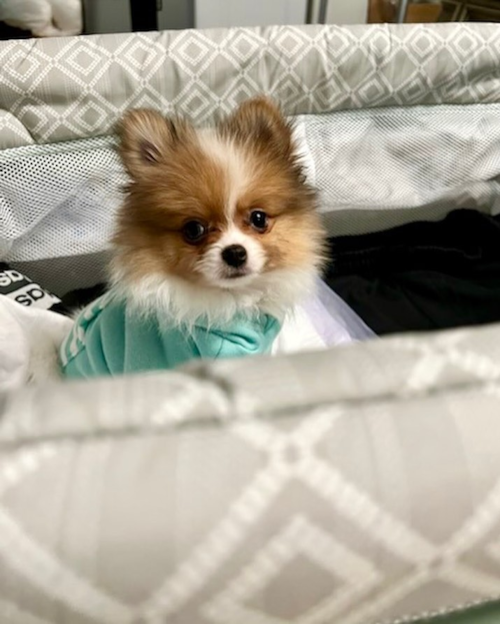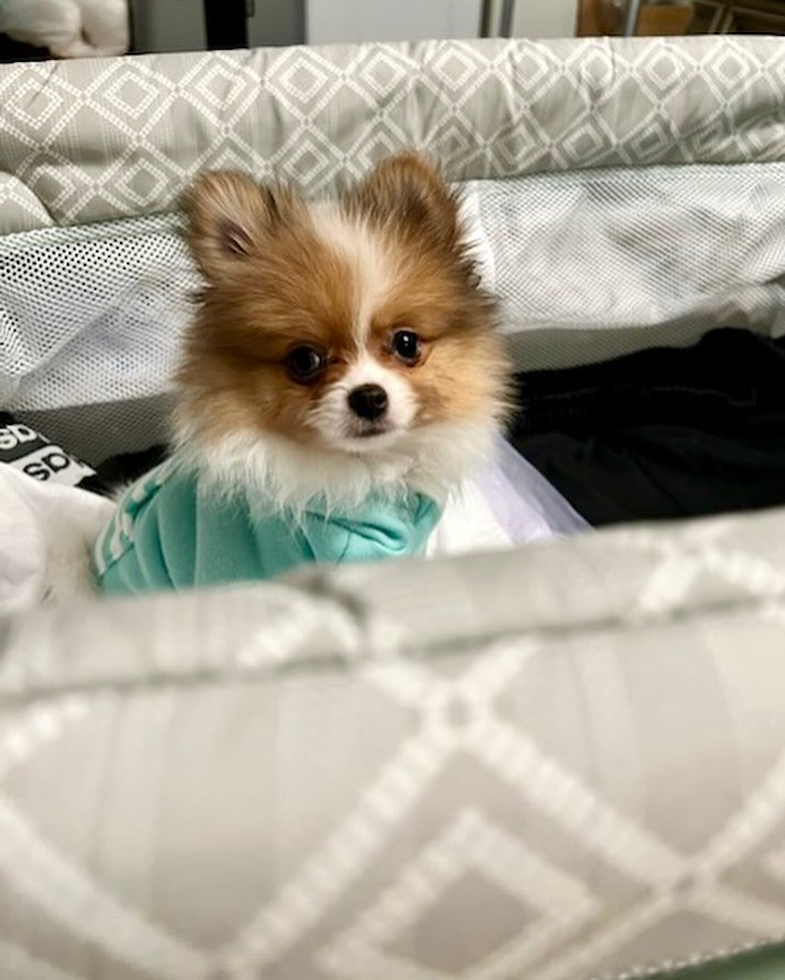Pomeranian Breed Information
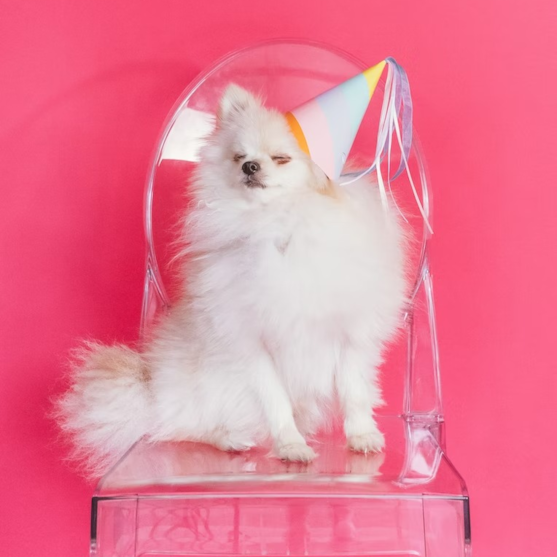
The Pomeranian dog breed is one of the most charming breeds you can have by your side. These little puppies love to play and be with people and are always looking for a way to make themselves a part of the action. The Pomeranian teacup puppies are small dogs with big personalities and there is no better pet for an individual or a family. They love to be involved in whatever their people are doing, whether it's snuggling on the couch or going on a long walk.
Characteristics
- The small Pomeranian size makes these dogs ideal for apartment living and great for families with children
- Pomeranian puppies are playful, intelligent, extroverted, and active dogs
- The Pomeranian dogs shed a moderate amount, so they require daily grooming in order to maintain a healthy coat
- The Pomeranian’s small size makes this dog a perfect companion for travel. These pups are excellent pets for apartment dwellers or anyone with limited space
- Pomeranian puppies and adults like to be involved in everything their owner is doing and will try to follow them around whenever possible
- The Pomeranian dog is a very intelligent, energetic, playful, social, and extroverted dog that loves being at the center of all things fun
- Pomeranian puppies are an excellent breed for senior families, families with children, and new or experienced owners
- The Pomeranian breed is recognized by the American Kennel Club as a member of their Toy Group
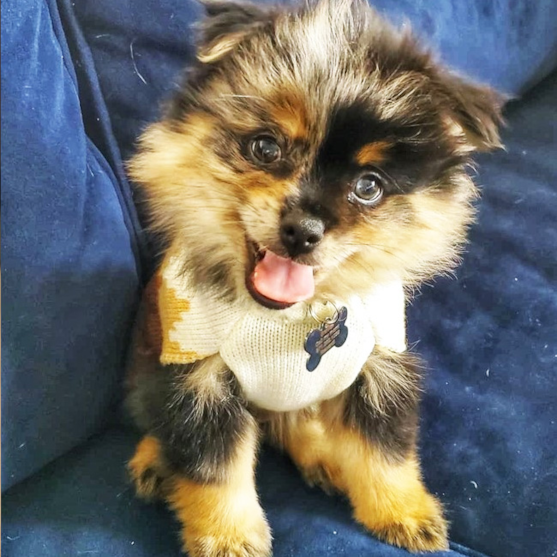
Appearance
The Pomeranian is a small, lively, and very active dog. The first impression of the Pomeranian is usually of a foxlike face with large eyes and a very bushy tail. It has a sturdy, compact, and well-muscled body with a thick undercoat which adds to its fluffy appearance.
The Pomeranian dog has a double coat that helps it stay comfortable during any type of weather. The Pomeranian teddy bear comes in many colors including red, cream, black, brown, orange, blue, and silver. The color of the nose will match the coat color; for example, if the dog is black, it will have a black nose or if it is brown it will have a brown nose.
Since the breed was created from spitz-type dogs its body structure is similar to that of the wolf and other primitive dogs. The Pomeranian tail is plumed, curled over the back, and carried over the back when in motion. Their ears tend to bend forward and downward giving them an alert expression. They have great eyesight and hearing despite their small size.
An adult Pomeranian’s weight will typically be between 4 and 7 pounds. The height of a full-grown Pomeranian can range from 8 to 11 inches.
The Pomeranian with blue eyes is most likely a crossbreed between a Pomeranian and a Siberian Husky. It is a famous designer breed that embodies the characteristics of both the Pomeranian and the Siberian Husky. The designer breed is called Pomsky.
Photos
Temperament
The Pomeranian is a small dog with a charming personality. You’ll find these pups hard to resist! The Pomeranians are devoted, happy, and outgoing dogs, particularly fond of the people they call their owners. If you’re looking for a smart, quick-to-please dog, a Pomeranian might be the perfect match for you.
The Pomeranian's size is an important attribute that creates versatility unmatched by other breeds. Pomeranian puppies are perfect companions for people who live in apartments and small homes. Their temperament is as unique as their size. The Pomeranian's bold spirit and high intelligence make them excellent candidates for advanced obedience training, as well as competitive obedience, agility, tracking, and conformation events.
The Pomeranian puppies love attention from their owners and thrive on praise for a job well done. They will learn everything you teach them very quickly so proper training is important.
Truly a playful dog, the Pomeranian enjoys games of fetch, hide-and-seek, or any sort of interaction that involves a lot of physical activity.
Care
Pomeranian Grooming
The first step in mastering Pomeranian grooming is understanding how to care for this breed's coat. Although it's somewhat short, it still needs to be brushed regularly to keep it from matting and tangling. The Pomeranian dog has a double coat, with a thick undercoat and long, straight guard hairs that form the outer coat. You might mistake the guard hairs for your dog's entire coat, but you have to look carefully to see that underneath, he has fur that's soft like felt.
The Pomeranian teddy bear, as some people call this breed, are naturally clean dogs and don't require too much maintenance in terms of their grooming. They need to be brushed a few times per week and bathed once every month or so. Cleaning their teeth is also important and should be done regularly to avoid dental decay. The Pomeranian’s ears should be checked and cleaned regularly, and its nails trimmed every few weeks.
Pomeranian Exercise Needs
These adorable miniature dogs are the smallest of the Spitz breed and are known for their cheerful demeanor and outgoing personalities. The Pomeranian dogs are eager to please; they’re sweet-natured, gentle, and friendly dogs that love taking trips to the dog park.
The Pomeranians are also an active breed that’s playful and charming. The American Kennel Club recommends daily exercise for Pomeranian puppies and adults alike. These dogs love to play, chase, and run around the yard. The best exercise routine for your Pomeranian dog should include 30 to 40 minutes of walks, runs, and interactive games. You can take your Pom puppies on walks or let them run freely in a fenced area. Mini Pomeranians don't need a lot of exercise and won't take up too much room in your home, so they're great companions if you live in an apartment.
Pomeranian Health
Pomeranian health is generally very good. It is important, however, to make sure that your Pom receives proper nutrition and plenty of exercise. This will ensure that it remains healthy and happy throughout its life. The Pomeranian dog is a very healthy breed.
There are issues that can arise, but they are few and far between. The most common problems that Pomeranians have are related to their teeth and eyes. Pomeranian dogs can develop gum disease and tartar build-up, which can be avoided through regular brushing. Conditions like cataracts and obesity, are also common in the Pomeranian breed. It’s important for owners of Pomeranian puppies — and all dogs — to have regular checkups with a veterinarian so any potential health issues can be detected early on and treated appropriately.
Pomeranian Life Span
The Pomeranian is a breed that’s been bred for its short stature and like most small dogs, Pomeranians have a long lifespan. These tiny dogs have enjoyed some of the best care and attention, which is reflected in their longevity. The Pomeranian has a life expectancy of 12 to 16 years.
Pomeranian Training
The Pomeranian dog is one of the most adorable dogs to ever exist. Their tiny stature and big personalities have won over many hearts. The most important thing you can do for your Pomeranian puppies is to train them early. Training your puppy teaches what is expected of them, and it also gives you an easy way to communicate with each other.
The first command you should teach your Pomeranian puppy is to sit. Teach them by placing a treat on the ground and then using the command “sit” while gesturing with your hand from their nose to the ground. When they follow instructions, reward them with a treat.
After you have taught your Pomeranian puppy to sit, it is time for the next step in training. You will want to train your Pomeranian pup to come when called upon using a recall word or phrase. Once you’ve mastered these two, you can move on to teaching commands that will instruct your puppy to leave what is off limits.
Socialization, leash training, and potty training can be done simultaneously once your puppy has become comfortable in its new home environment.
Remember that repetition is key in training and will help foster success in your adult Pomeranian dog. You’ll make better progress if you train your Pomeranian puppy with love and praise rather than with fear or the use of punishment. Pomeranian dogs are sensitive, especially as puppies, so it is recommended to use a gentler approach when training them rather than applying any sort of harsh treatment.
History
The Pomeranian dog is one of the most eye-catching and distinctive dog breeds. It is an intelligent and lively companion, loyal to its owner and full of affection. It makes a wonderful family dog and can also be used as a watchdog or assistance dog with the right training.
The first written reference to the Pomeranian dog was in 1418, by a German monk named Rembert, who described a small spitz-type dog from Pomerania. It is thought that the ancestors of today's Pomeranians arrived with Vikings from Scandinavia around 1000 AD. The word "Pomeranian" comes from the Pomerania region in what is now Poland.
The breed's ancestors are the German Spitz and other Nordic breeds like the Samoyed. (The word Spitz means sharp pointed in German.) The Pomeranian’s origins are not clearly known. We do know that this dog is a Spitz type, most likely descended from Arctic dogs that lived in the frozen tundra of Iceland. These dogs were much larger than the cute Pomeranian we know today. They were used for herding, pulling sleds, and guarding their owners' property.
The Pomeranian dog is the smallest dog breed in the toy category, and it is believed that this breed began with the Spitz family of dogs. These dogs were used by both Europeans and Native Americans hundreds of years ago. The Pomeranian was brought to England around 1860, and from there it made its way to the Americas.
The first Pomeranian baby was brought to England by Queen Victoria, who wanted a dog she could travel within her carriage. She fell in love with the mini Pomeranian and had several of her own throughout her life. Her son, King Edward VII, had several Pomeranian puppies as well. The Queen's love for these tiny dogs became popular among the English people and led to the popularity of the Pomeranian we see today. Queen Victoria became so enamored with the breed that she made it fashionable for women to carry these small dogs around in their purses and use them as lapdogs. This is how the popular name "Purse Dog" came about.
Teddy Roosevelt was a famous fan of the Pomeranian dog breed. The breed has also been popular among other politicians such as Winston Churchill.
The Pomeranian breed has become even more popular in the last decade, leading to the breed’s selection for various crossbreeds. The Pomeranian is now a parent to over 20 designer breeds among which the most popular are the Pomsky – Pomeranian Husky mix, Pomapoo – Pomeranian Poodle mix, Maltipom – Maltese Pomeranian mix, and Pomachon – Pomeranian Bichon Frise mix.






